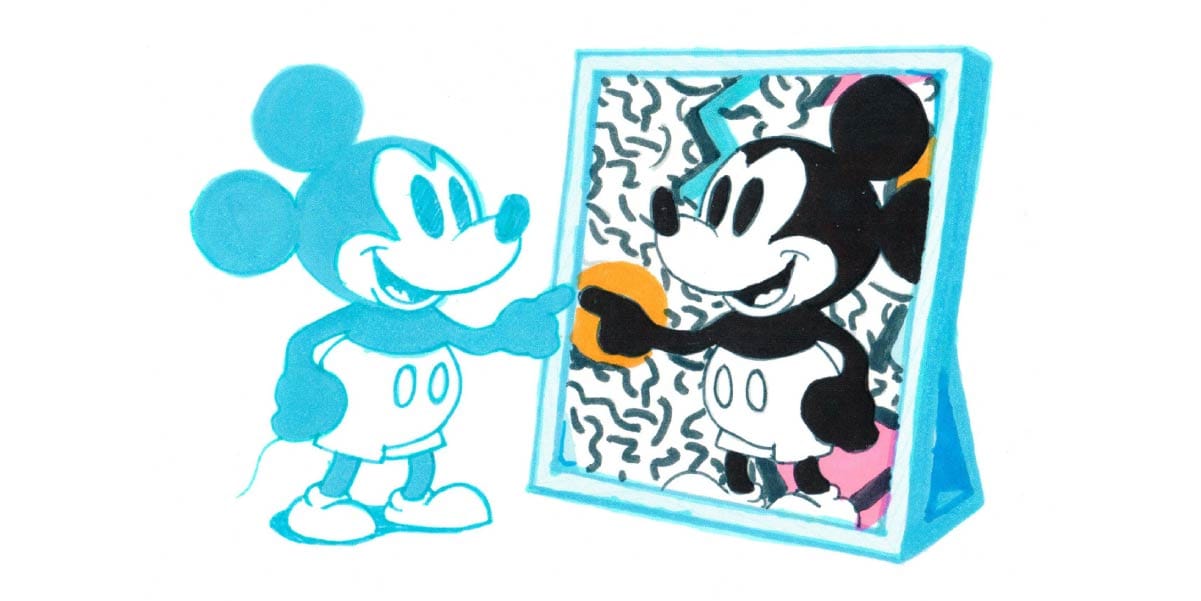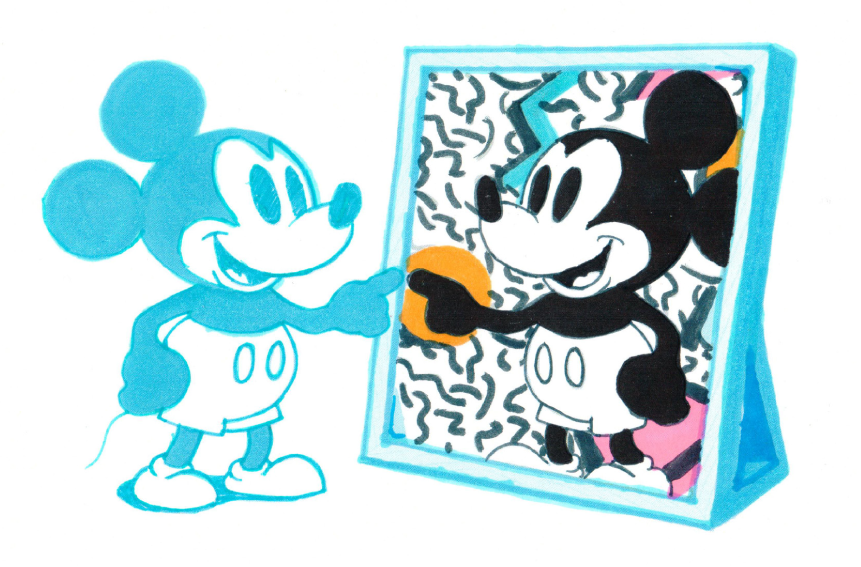Marketing Like the Mouse
How Disney Channel’s rebrand sparked decades of success—and what your schools can learn from it


Marketing Like
The Mouse
It was the mid-1990s. The internet was just beginning to take off. Butterfly clips and cargo pants were all the rage. And The Disney Channel was on the verge of making a massive strategic shift
You may not remember the version of The Disney Channel that existed pre-1997. For one thing, it was only available to paying subscribers. But more significantly, as culture journalist Ashley Spencer writes in her book Disney High, “the network had no definitive identity.” The programming included everything from Mickey Mouse-led dance workouts to nature shows to Willie Nelson concerts. They were throwing everything at the wall, and nothing was sticking.
It was clear something needed to change, and multiple high-level hires were brought in to lead the charge. Among them was Rich Ross, a former Nickelodeon executive and one of the founders of FX. Ross, who joined the channel as senior vice president of programming and production, would go on to have a storied career with Disney, eventually becoming chairman of The Walt Disney Studios. But first, he helped completely revolutionize The Disney Channel.
If you’re familiar with The Disney Channel, it’s probably the version that existed after Ross’s arrival: the one that produced “Lizzie McGuire,” “High School Musical,” “Hannah Montana” and other “tween” phenomenons. So how did The Disney Channel go from a forgettable mishmash of programs in the '90s to a channel with two million average viewers in the 2010s? And what the heck does it have to do with schools? Ross (who happens to be the child of a public school teacher) sat down with us to offer his take. Read on to learn about one of the most successful rebrands in entertainment history—and what your district can take away from it.
Narrow down your target audience.
Before they could move the needle on The Disney Channel’s viewership, Ross and other execs had to answer a crucial question: Who are we trying to reach? Prior to 1997, the only clear answer was “families”; the channel even billed itself as “America’s family network.” But attempting to appeal to every member of every family in America had left The Disney Channel appealing to, well, hardly anyone. Its programming—from “Mousercise” to the live broadcast of the American Teacher Awards—was broadly unobjectionable, but totally incohesive.
So instead of targeting all families, The Disney Channel zeroed in on the families of "tweens"—kids from about 8 to 15, who were between childhood and adolescence. Why? According to Ross, the rationale was pretty simple. “They were left behind,” he tells SchoolCEO. While preschool-aged kids, teens and adults all had plenty of entertainment options, there was very little programming targeted to this in-between group. “The film business had started getting a little raunchier—with a little more horror, a little more action—not necessarily really embracing 8- to 15-year-olds,” Ross says. “There seemed to be this hole.” So the network stepped in to fill that gap. They went on to completely overhaul their programming, producing new original shows and movies with tween stars.
Your schools may face a similar problem. Just like The Disney Channel of yesteryear, you may be trying to make your brand appeal to all families—or at least all the families in your area. But, somewhat paradoxically, brands that try to resonate with everyone often end up resonating with no one. You’ll likely gain more traction if you go all in on one or two specific target audiences.
To determine who to target, ask yourself: Which families in your area don’t have what they’re looking for in terms of education? Do working parents have enough options for after-school care? Do non-English speaking families have what they need to communicate effectively with schools? If you’re not sure, you might run a communitywide survey to determine what gaps exist in your local education landscape.
Once you have the answer, consider how you can give those audiences what they’re looking for. For example, if non-English speakers in your area aren’t getting the support they need from other schools, consider offering better EL programming or translation services. Of course, unlike The Disney Channel, you may not have the resources to radically revamp your program offerings. But it also may be that you already have what families are looking for and just aren’t marketing it well enough. If you have stellar after-school programs, make sure those parents desperate for after-school care know about them.
As Ross puts it, “If you're smart, you identify who doesn't have what they're looking for.” Then, one way or another, you fill the gaps.
Don’t rebrand for the sake of rebranding.
There’s a common misconception in the world of school marketing that a rebrand is little more than a fresh logo, some updated colors and maybe a new font. But while rebrands almost always include visual adjustments, those shifts will ring hollow if they’re not accompanied by deeper change. In fact, the best rebrands use those more tangible changes simply to mark and reinforce a more significant shift.
That was certainly the case for The Disney Channel. Their transformation in the late ‘90s was marked by concrete changes to their brand—but every change they made, they made with purpose. First, they dropped “The” from the network’s name, becoming simply “Disney Channel.” The change was specifically designed to appeal to the network’s new target audience. Tweens, they believed, were more likely to associate The Disney Channel with stodgy “adult” networks like The History Channel or The Travel Channel.
The channel’s logo underwent a similar shift to become more palatable to tweens. Where the original mark was sophisticated but plain—a silhouette of Mickey Mouse over horizontal lines—the new one was more colorful and playful: a TV box with mouse ears.
Our point here? Disney Channel wasn’t making superficial changes to its brand simply for change’s sake. Instead, it came in with a specific goal in mind—to better reach tween audiences—and used its rebrand as a means to that end.
If your district is considering a rebrand, here are a few questions to discuss with your team:
- What exactly are we trying to accomplish with this rebrand?
- How could changes to the most tangible elements of our brand, like logos or slogans, help us accomplish that goal?
- What changes are we making to our district beyond those visible elements?
If Disney Channel had done nothing but remove an article from its name and change its logo, it would never have become a ratings juggernaut. The total shift in direction is what drove its success. So decide what deep-down changes your district needs to make, and then let your rebrand complement and reinforce them.
Don’t forget to appeal to kids.
As it transitioned from a premium channel to basic cable, Disney Channel began to realize that kids’ opinions mattered. While parents had once been the key decision-makers—choosing whether or not to subscribe—kids could now choose Disney just by changing the channel.
“Before I came in, Disney Channel wasn’t programming to kids. They were programming to parents for their kids,” Ross says. But that strategy had failed to resonate. Parents wanted their kids to watch TV that was safe and age-appropriate, and Disney had delivered on that front. But as you might imagine, “safe and age-appropriate” covered a pretty wide range of content—and not all of it appealed to tweens.
So even as they refocused their programming, Disney Channel also had to retool their marketing. The goal was both to fulfill their original brand promise—keeping parents comfortable with what their children were watching—and also to convince the tweens themselves to tune in. Before long, segments interviewing the channel’s stars began appearing during commercial breaks. Tween sensations like Hilary Duff and Shia LaBeouf shared their favorite foods, stories about their parents and even their most embarrassing moments—positioning themselves as “regular kids” to whom viewers could relate. “We wanted it to feel like these were people like you, friendships like yours, family relationships like yours,” says Ross. A later series of ads would even say so explicitly: “Disney Channel stars are just like you.”
The strategy worked. By 2007, Disney Channel was the top cable network in prime time, with more than 2.6 million viewers. Tweens were watching, and they were even bringing their parents along for the ride. “It was what we called ‘kid-driven family,’” Ross explains. “Kids would say, ‘I want to watch this,’ and parents would watch along with them.”
“You could argue that the situation in education is not dissimilar—speaking to parents or speaking to kids,” Ross says. And he’s right. Most times, when we think about school brands, we’re thinking about adults: parents deciding where to send their kids, voters deciding how to vote on bond initiatives or teachers deciding where to apply for jobs. But the group who experiences your schools more directly than almost any other stakeholder is your students. What do they think? How do they feel?
Kids may not be the final decision-makers in where they go to school, but their opinions and experiences certainly matter to their parents. Why would families be excited about your school district if their child isn’t?
So how do you actually engage students in your district brand? The answer could be to highlight your programming—like a new and exciting lineup of extracurriculars. It might be placing students front and center in your social media, showing kids what others “just like them” love about your district. No matter what avenue you choose to reach them, you can’t afford to forget your most crucial stakeholders.

